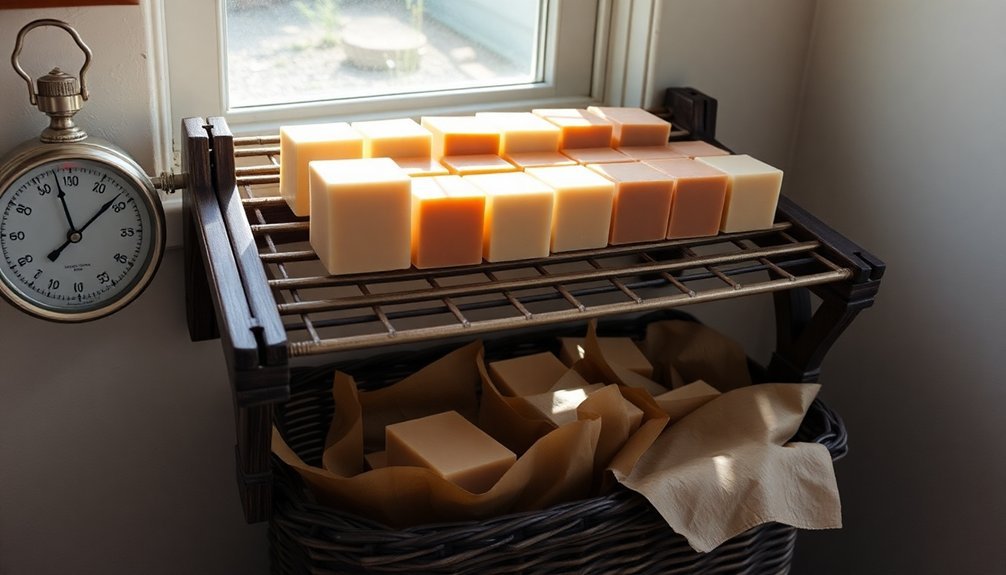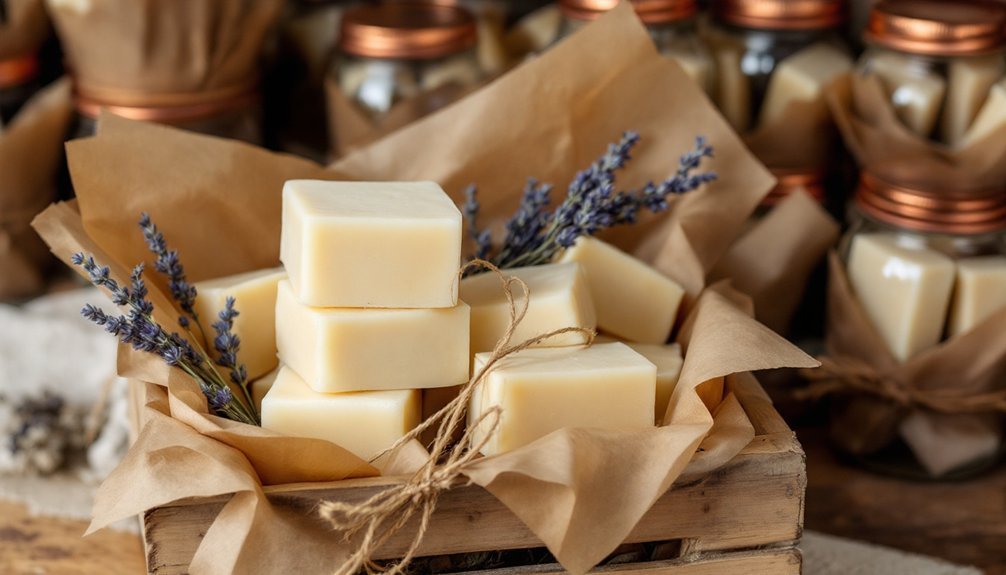Properly store your homemade animal fat soap by first curing it for at least four weeks to complete saponification. Keep your bars in a temperature-controlled space between 40-70°F, like a basement, with good air circulation. Space bars apart on breathable shelving and wrap them in natural materials like muslin or parchment paper. Label each bar with creation dates and ingredients, and check monthly for quality. Discover how these essential storage methods can extend your soap's shelf life up to two years.
Essential Curing Requirements Before Storage

Before storing your homemade animal fat soap, proper curing is vital for achieving the best quality and longevity. You'll need to dedicate at least four weeks of cure time in a well-ventilated space to guarantee complete saponification and lye neutralization.
To promote ideal air circulation during the curing process, place your soap bars with enough space between them.
Space your handcrafted soap bars apart during curing to ensure proper airflow and optimal results.
Maintaining proper moisture levels is important, so keep your soaps at room temperature around 70°F (21°C). This temperature helps prevent overheating while supporting the hardening of bars.
Don't rush to soap storage before the bars are fully cured. You'll know they're ready when they've become completely firm.
Taking the time to guarantee proper curing will maximize your soap's shelf life and create a better product for your skin.
Temperature-Controlled Storage Locations

Your basement offers an ideal environment for soap storage, maintaining a steady temperature around 40°F similar to your refrigerator.
You'll find that cool, dry basements help prevent seasonal temperature fluctuations that can affect your soap's quality, especially during hot summers.
When choosing your storage area, aim for consistent room temperatures between 40-70°F, using fans or dehumidifiers to manage airflow and moisture levels throughout the year.
Cool Basement Storage Tips
When storing homemade animal fat soap, a cool basement provides an ideal environment similar to refrigerator conditions, maintaining temperatures around 40 degrees Fahrenheit.
To maximize your storage location's effectiveness, you'll need to guarantee proper air circulation and minimize moisture buildup that can lead to spoilage.
Set up shelving units to keep your soap bars elevated and spaced apart, allowing air to flow freely between them. Keep your soap away from pest-prone areas and check regularly for signs of deterioration, such as unusual odors or sticky surfaces.
If you notice temperature fluctuations in your basement rising above room temperature, you can adapt by placing your soap in sealed containers with ice packs.
Remember that a dry environment is essential, so monitor humidity levels to protect your soap from potential damage.
Optimal Room Temperature Range
To maintain the highest quality of your homemade animal fat soap, storing it at temperatures between 60°F and 75°F (15°C to 24°C) provides excellent conditions for long-term preservation.
You'll want to store your soap in a cool, dry place away from direct sunlight to prevent rancidity and preserve soap quality.
Temperature-controlled storage locations, such as a basement or dedicated storage room, offer the perfect environment for your handcrafted soaps.
Don't keep them in areas with high humidity, as moisture can lead to mold growth and reduce their extended shelf life.
It's important to monitor storage environment conditions regularly to guarantee temperature stability.
Managing Seasonal Temperature Changes
Seasonal temperature shifts pose unique challenges for soap storage throughout the year. To maintain your homemade animal fat soap's quality, you'll need to identify a temperature-controlled environment that stays between 60°F to 70°F (15°C to 21°C).
Your basement can be an ideal storage location, as it typically maintains a stable temperature and helps prevent rancidity.
Avoid keeping your soap in places with extreme temperature fluctuations, like attics or uninsulated garages, which can drastically reduce soap shelf life. If possible, use a dedicated climate-controlled room that guarantees peak air circulation and moisture control.
You'll want to regularly check humidity levels and keep monitoring temperature in your chosen storage space. By staying vigilant with these conditions, you'll protect your soap investment and maintain its quality year-round.
Proper Air Circulation Methods

Since proper air circulation is essential for preserving homemade soap, you'll need to create an environment that allows your bars to breathe.
To store their soap effectively, crafters should space each bar apart to prevent moisture buildup and extend shelf life. Open-air shelving or wooden storage units offer excellent ventilation, ensuring proper airflow around your homemade soap.
Don't make the mistake of using airtight containers, which can trap moisture and cause your soap bars to spoil. Instead, opt for cardboard boxes with ventilation holes – they're both cost-effective and practical for maintaining air circulation.
Keep an eye on your stored soap by checking regularly for any unusual odors or dampness, as these signs suggest poor ventilation. This simple monitoring practice will help maintain your soap's quality over time.
Natural Wrapping Materials and Techniques

When choosing natural materials to wrap your homemade soap, breathable options like unbleached muslin, cotton fabric, and parchment paper offer the best protection while maintaining essential airflow.
Beeswax wraps provide an excellent moisture barrier while allowing proper air circulation, making them an ideal sustainable choice for your soap storage needs.
Eco-friendly beeswax wraps strike the perfect balance between moisture protection and breathability, keeping handmade soaps fresh naturally.
Before wrapping, verify your soap's fully cured to minimize moisture content. You'll want to avoid plastic wrap or other non-breathable materials that can trap moisture and lead to rancidity.
For a finishing touch, secure your natural wrapping materials with jute twine or natural string. This not only keeps the wrap in place but also adds an attractive, rustic appearance to your soap.
These natural alternatives help maintain your soap's quality while being environmentally conscious.
Climate-Specific Storage Solutions

Your homemade soap's longevity depends heavily on the climate where you store it. If you're in a humid environment, you'll need a dehumidifier in your storage area to prevent moisture absorption that can lead to rancidity.
Keep your homemade soaps away from bathrooms and kitchens, where humidity levels are naturally higher.
For cooler climates, a dark, cool basement provides ideal storage conditions, provided the temperature remains stable.
In warmer regions, consider refrigeration to extend your soap's shelf life and prevent fat from spoiling.
Regardless of your climate, proper air circulation is essential for maintaining soap quality. You can achieve this by spacing your soaps apart and using breathable storage containers.
This approach helps minimize oxidation and guarantees your handcrafted soaps maintain their quality longer.
Organizing and Labeling Systems
Establishing an effective organization system for homemade soaps starts with proper labeling and strategic placement. You'll want to create clear labels indicating the date made, scent, and special ingredients on cardboard boxes to help with tracking your soap inventory.
Implement a color-coded labeling system for categorizing your soap bars by type, making selection quick and effortless.
Your storage setup should prioritize airflow, so consider using open-air shelving or ventilated plastic baskets that you can stack efficiently. By maintaining space between each bar, you'll extend their shelf life and preserve freshness.
Don't forget to regularly check your labels and update them if you notice any changes in soap quality. This systematic approach guarantees you'll use older bars first and minimize waste in your homemade soap collection.
Storage Duration and Quality Monitoring
Your homemade soap's shelf life can extend up to two years when stored properly in cool, dry conditions away from direct sunlight.
You'll need to watch for key signs of degradation, including rancid odors and unusual stickiness, which indicate it's time to discard the soap.
Make quality monitoring easier by checking your dated labels monthly and maintaining proper spacing between bars to prevent moisture-related deterioration.
Shelf Life Factors
While homemade soaps can provide a natural alternative to commercial products, understanding their shelf life is essential for maintaining quality.
If you're making tallow soap, you'll want to keep in mind that it typically lasts one to two years when stored properly. The shelf life largely depends on your choice of fats and oils, with olive oil-based soaps lasting longer than those made with alternatives like grapeseed oil.
To maximize your soap's longevity, focus on proper storage in a cool, dry place with good air circulation. Keep your soaps away from direct sunlight to prevent deterioration.
Don't forget to label soaps with production dates and use-by dates. Watch for signs of spoilage, such as rancid odors or unusual stickiness, which indicate it's time to discard the soap.
Signs of Degradation
Careful monitoring of your homemade soap's condition can help you spot early signs of degradation before the soap becomes unusable.
Watch for signs of rancidity, including off-putting smells or unusual stickiness that indicates your soap's quality has declined.
To maximize shelf life, keep your stored soap bars in a cool, dry place and protect them from direct sunlight.
You'll want to guarantee proper air circulation by keeping bars separated rather than stacked together.
Don't forget to label soaps with their creation date and recommended use-by date to track freshness.
While animal fat soaps typically last at least a year, different ingredients affect longevity.
For example, olive oil-based soaps tend to last longer than those made with grapeseed or palm oil.
Regular checks of your stored bars will help maintain ideal quality.
Frequently Asked Questions
How Long Does Animal Fat Soap Last?
Your animal fat soap will typically last up to one year when stored properly. You'll want to check for rancid smells or stickiness, but with essential oils and good curing, it could last longer.
What's the Best Way to Store Homemade Soap?
You'll want to store your homemade soap in a cool, dry place with good air circulation. Don't keep it in humid areas. Use ventilated containers and label each bar with its production date.
Do I Need FDA Approval to Sell Soap?
You don't need FDA approval to sell soap that's marketed as a cosmetic. However, if you make therapeutic claims, it becomes a drug requiring FDA approval. Do follow labeling requirements and local regulations.
What Should You Wrap Homemade Soap In?
You'll want to wrap your homemade soap in breathable materials like parchment paper or butcher paper. Don't use plastic wrap, as it traps moisture. Paper bags and cardboard boxes with ventilation work well too.
In Summary
Store your handmade animal fat soap properly by following these storage methods to maximize its shelf life and maintain quality. You'll need to cure it completely, control temperature and airflow, use natural wrapping materials, and monitor conditions based on your climate. Remember to label and organize your soaps, and check them regularly. With proper care, you'll enjoy your handcrafted soaps for months to come.





Leave a Reply